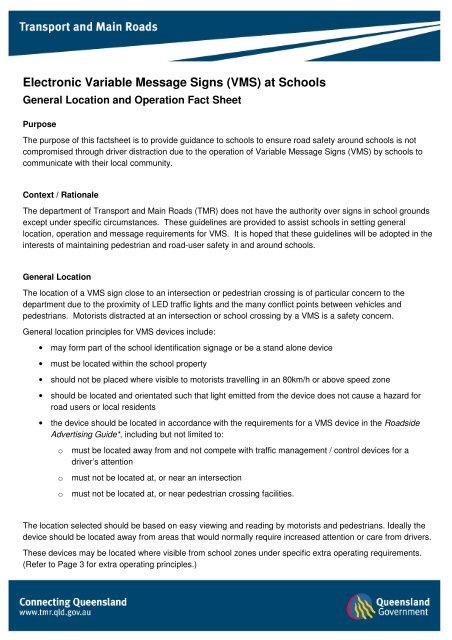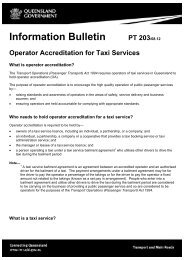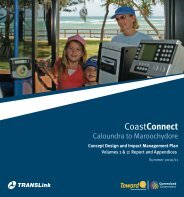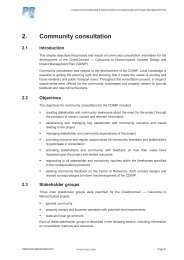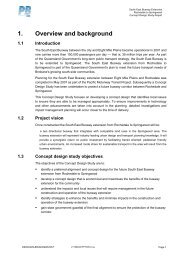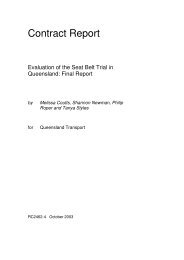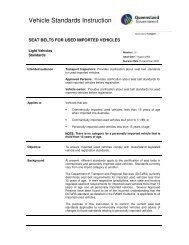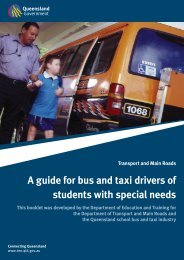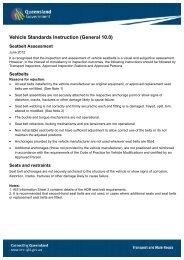Electronic Variable Message Signs (VMS) - Department of Transport ...
Electronic Variable Message Signs (VMS) - Department of Transport ...
Electronic Variable Message Signs (VMS) - Department of Transport ...
Create successful ePaper yourself
Turn your PDF publications into a flip-book with our unique Google optimized e-Paper software.
<strong>Electronic</strong> <strong>Variable</strong> <strong>Message</strong> <strong>Signs</strong> (<strong>VMS</strong>) at Schools<br />
General Location and Operation Fact Sheet<br />
Purpose<br />
The purpose <strong>of</strong> this factsheet is to provide guidance to schools to ensure road safety around schools is not<br />
compromised through driver distraction due to the operation <strong>of</strong> <strong>Variable</strong> <strong>Message</strong> <strong>Signs</strong> (<strong>VMS</strong>) by schools to<br />
communicate with their local community.<br />
Context / Rationale<br />
The department <strong>of</strong> <strong>Transport</strong> and Main Roads (TMR) does not have the authority over signs in school grounds<br />
except under specific circumstances. These guidelines are provided to assist schools in setting general<br />
location, operation and message requirements for <strong>VMS</strong>. It is hoped that these guidelines will be adopted in the<br />
interests <strong>of</strong> maintaining pedestrian and road-user safety in and around schools.<br />
General Location<br />
The location <strong>of</strong> a <strong>VMS</strong> sign close to an intersection or pedestrian crossing is <strong>of</strong> particular concern to the<br />
department due to the proximity <strong>of</strong> LED traffic lights and the many conflict points between vehicles and<br />
pedestrians. Motorists distracted at an intersection or school crossing by a <strong>VMS</strong> is a safety concern.<br />
General location principles for <strong>VMS</strong> devices include:<br />
• may form part <strong>of</strong> the school identification signage or be a stand alone device<br />
• must be located within the school property<br />
• should not be placed where visible to motorists travelling in an 80km/h or above speed zone<br />
• should be located and orientated such that light emitted from the device does not cause a hazard for<br />
road users or local residents<br />
• the device should be located in accordance with the requirements for a <strong>VMS</strong> device in the Roadside<br />
Advertising Guide*, including but not limited to:<br />
o must be located away from and not compete with traffic management / control devices for a<br />
driver’s attention<br />
o must not be located at, or near an intersection<br />
o must not be located at, or near pedestrian crossing facilities.<br />
The location selected should be based on easy viewing and reading by motorists and pedestrians. Ideally the<br />
device should be located away from areas that would normally require increased attention or care from drivers.<br />
These devices may be located where visible from school zones under specific extra operating requirements.<br />
(Refer to Page 3 for extra operating principles.)
* The Roadside Advertising Guide is available on the <strong>Transport</strong> and Main Roads website - http://www.tmr.qld.gov.au/<br />
Operating Principles<br />
How the <strong>VMS</strong> are used can also have a significant bearing on the potential for excessive motorist distraction.<br />
Schools programming the <strong>VMS</strong> to flash, scroll and/or display multiple quick messaging can distract motorists<br />
for longer periods, than if a single succinct message is displayed without moving. The following principles<br />
should be considered when operating <strong>VMS</strong> devices:<br />
• The <strong>VMS</strong> device should be limited to a maximum <strong>of</strong> 4 lines <strong>of</strong> text, each with provision for a maximum<br />
<strong>of</strong> 18 characters.<br />
• A font height (letter size) should be selected to enable quick and easy reading <strong>of</strong> the message by both<br />
motorists and pedestrians. As a guide the minimum font height shall be 150mm for a device in a<br />
60km/h or less speed zone.<br />
• Its use to be restricted to the display <strong>of</strong> information specific to the operation <strong>of</strong> the school and must not<br />
be used for other purposes (eg advertising local businesses etc).<br />
• Text only displays are to be used (graphics are not permitted).<br />
• Each complete message is to be contained within the one <strong>VMS</strong> display screen (a message must not<br />
continue over more than one screen).<br />
• The amount <strong>of</strong> text displayed should be kept to a minimum (for example no more than a driver can read<br />
at a short glance). Although a typical <strong>VMS</strong> may have up to 4 lines <strong>of</strong> 18 characters, it is NOT<br />
necessary to “fill” the screen.<br />
• Each message should be displayed for a period that limits the amount <strong>of</strong> drivers that will see<br />
(potentially be distracted by) a message change while driving past. A minimum display time <strong>of</strong> 10<br />
minutes is suggested, but the longer a message can be displayed the better.<br />
• Each change <strong>of</strong> message should be completed instantaneously (within 0.1 <strong>of</strong> a second).<br />
• <strong>Message</strong>s must remain static. They are not to move (fading or flying in or out, or scrolling across the<br />
screen etc.) or blink (flash) or change brightness.<br />
• Text displayed in a single screen must be the one colour (multiple colours are not permitted). White<br />
and yellow are the preferred colours for text on <strong>VMS</strong> displays. The use <strong>of</strong> red and green text colours is<br />
not desirable especially in close proximity to traffic signals.<br />
• Text displayed in a single screen must be all the same style (font) and size (height).<br />
• In the event <strong>of</strong> a malfunction, the <strong>VMS</strong> device must display (default to) a blank screen.<br />
Brightness / Luminance<br />
Luminance characteristics for advertising devices shall accord with the requirements outlined in Appendix D <strong>of</strong><br />
the Roadside Advertising Guide, except as varied below.<br />
<strong>Electronic</strong> <strong>Variable</strong> <strong>Message</strong> <strong>Signs</strong> (<strong>VMS</strong>) at Schools, <strong>Transport</strong> and Main Roads, December 2010, Version 1.0<br />
2 <strong>of</strong> 3
<strong>Electronic</strong> and digital advertising devices shall have the following maximum average luminance levels:<br />
• Daytime – 2000 cd/m2<br />
• Night – 60 cd/m2<br />
The maximum average luminance listed above is the maximum allowed. The electronic and digital advertising<br />
device should contain a light sensor to measure the levels <strong>of</strong> ambient light in the surrounding environment and<br />
adjust the brightness or luminance <strong>of</strong> the advertising device in accordance with the measured ambient light<br />
levels. <strong>Signs</strong> that do not contain a light sensor must regulate the luminance output based on the time <strong>of</strong> day.<br />
Extra Operating Principles for Devices Located at School Zones<br />
When the <strong>VMS</strong> device is located such that it is visible from a school zone the following specific extra operating<br />
requirements must apply:<br />
• The message is to remain static (not change) during the following times for an AM and PM school zone<br />
- 6:30am to 9:30am and 1:30pm to 4:30pm<br />
• The message is to remain static (not change) during the following times for an ALL DAY school zone<br />
- 6:30am to 4:30pm.<br />
Extra Operating Principles for EXISTING Devices Located within <strong>VMS</strong> restriction zones<br />
When an existing <strong>VMS</strong> device is located within a defined restriction zone (refer the Roadside Advertising<br />
Guide) and cannot be relocated (for example due to cost or specific site constraints), the following specific<br />
extra operating requirements must apply:<br />
• For safety reasons, the message is to remain static and may only be changed once per day at<br />
midnight.<br />
<strong>Message</strong> Content<br />
<strong>Message</strong>s displayed on the <strong>VMS</strong> should be short and succinct. A standard message format suite should be<br />
developed by Education Queensland and used by all schools for the majority <strong>of</strong> messages. Possible examples<br />
may include:<br />
School Term 1 Fete P & C Meeting<br />
Commences Saturday 26 March 6pm Wed 19 May<br />
Monday 26 January 7am till 3pm In the School Hall<br />
Contact: If you have any queries on these guidelines, please contact the Road and Corridor Use Unit,<br />
<strong>Department</strong> <strong>of</strong> <strong>Transport</strong> and Main Roads on 3834 9483.<br />
<strong>Electronic</strong> <strong>Variable</strong> <strong>Message</strong> <strong>Signs</strong> (<strong>VMS</strong>) at Schools, <strong>Transport</strong> and Main Roads, December 2010, Version 1.0<br />
3 <strong>of</strong> 3


